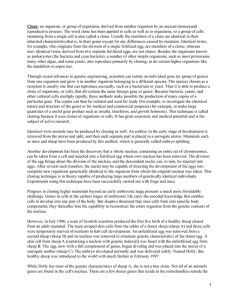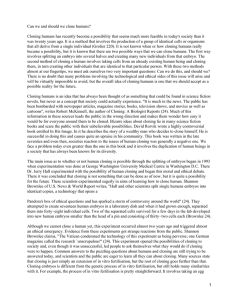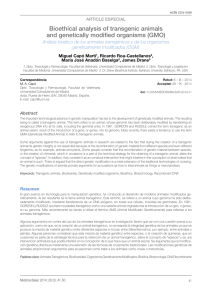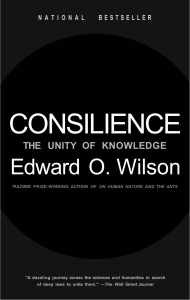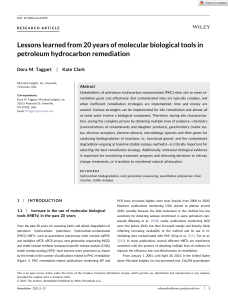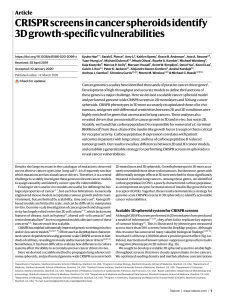Documento 11234
Anuncio
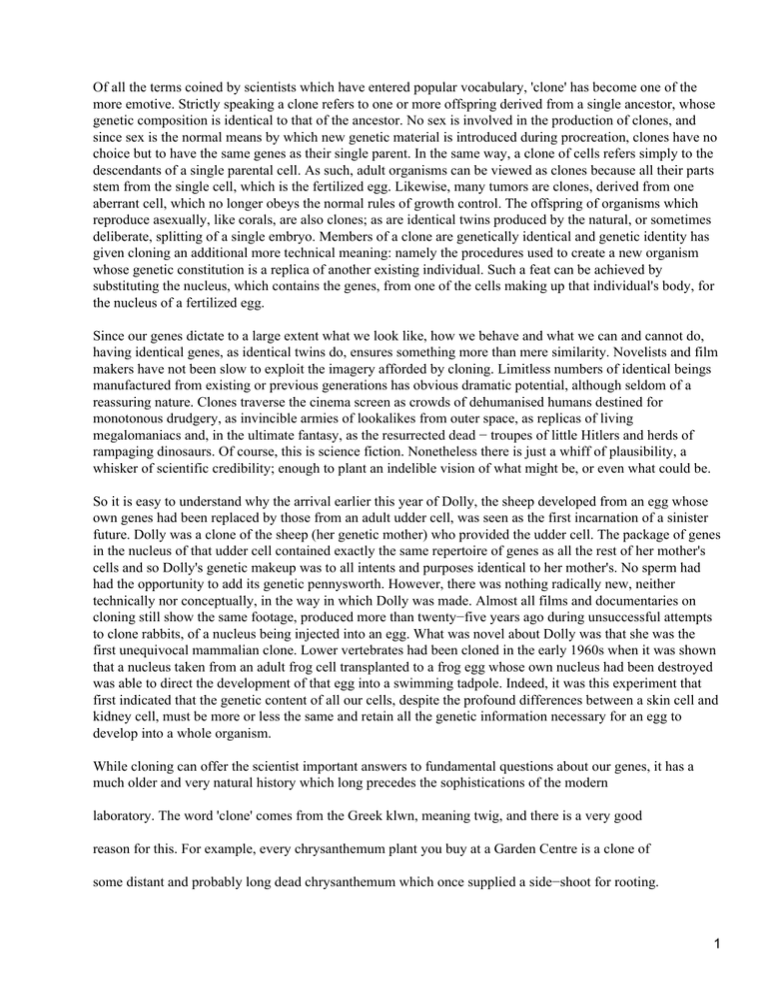
Of all the terms coined by scientists which have entered popular vocabulary, 'clone' has become one of the more emotive. Strictly speaking a clone refers to one or more offspring derived from a single ancestor, whose genetic composition is identical to that of the ancestor. No sex is involved in the production of clones, and since sex is the normal means by which new genetic material is introduced during procreation, clones have no choice but to have the same genes as their single parent. In the same way, a clone of cells refers simply to the descendants of a single parental cell. As such, adult organisms can be viewed as clones because all their parts stem from the single cell, which is the fertilized egg. Likewise, many tumors are clones, derived from one aberrant cell, which no longer obeys the normal rules of growth control. The offspring of organisms which reproduce asexually, like corals, are also clones; as are identical twins produced by the natural, or sometimes deliberate, splitting of a single embryo. Members of a clone are genetically identical and genetic identity has given cloning an additional more technical meaning: namely the procedures used to create a new organism whose genetic constitution is a replica of another existing individual. Such a feat can be achieved by substituting the nucleus, which contains the genes, from one of the cells making up that individual's body, for the nucleus of a fertilized egg. Since our genes dictate to a large extent what we look like, how we behave and what we can and cannot do, having identical genes, as identical twins do, ensures something more than mere similarity. Novelists and film makers have not been slow to exploit the imagery afforded by cloning. Limitless numbers of identical beings manufactured from existing or previous generations has obvious dramatic potential, although seldom of a reassuring nature. Clones traverse the cinema screen as crowds of dehumanised humans destined for monotonous drudgery, as invincible armies of lookalikes from outer space, as replicas of living megalomaniacs and, in the ultimate fantasy, as the resurrected dead − troupes of little Hitlers and herds of rampaging dinosaurs. Of course, this is science fiction. Nonetheless there is just a whiff of plausibility, a whisker of scientific credibility; enough to plant an indelible vision of what might be, or even what could be. So it is easy to understand why the arrival earlier this year of Dolly, the sheep developed from an egg whose own genes had been replaced by those from an adult udder cell, was seen as the first incarnation of a sinister future. Dolly was a clone of the sheep (her genetic mother) who provided the udder cell. The package of genes in the nucleus of that udder cell contained exactly the same repertoire of genes as all the rest of her mother's cells and so Dolly's genetic makeup was to all intents and purposes identical to her mother's. No sperm had had the opportunity to add its genetic pennysworth. However, there was nothing radically new, neither technically nor conceptually, in the way in which Dolly was made. Almost all films and documentaries on cloning still show the same footage, produced more than twenty−five years ago during unsuccessful attempts to clone rabbits, of a nucleus being injected into an egg. What was novel about Dolly was that she was the first unequivocal mammalian clone. Lower vertebrates had been cloned in the early 1960s when it was shown that a nucleus taken from an adult frog cell transplanted to a frog egg whose own nucleus had been destroyed was able to direct the development of that egg into a swimming tadpole. Indeed, it was this experiment that first indicated that the genetic content of all our cells, despite the profound differences between a skin cell and kidney cell, must be more or less the same and retain all the genetic information necessary for an egg to develop into a whole organism. While cloning can offer the scientist important answers to fundamental questions about our genes, it has a much older and very natural history which long precedes the sophistications of the modern laboratory. The word 'clone' comes from the Greek klwn, meaning twig, and there is a very good reason for this. For example, every chrysanthemum plant you buy at a Garden Centre is a clone of some distant and probably long dead chrysanthemum which once supplied a side−shoot for rooting. 1 Likewise, whenever you divide an overgrown shrub or successfully cultivate a houseplant cutting you are cloning. In each case you are deliberately propagating a copy of the parent, and eventually over successive years and many hours in the greenhouse, producing a multitude of plants (clones) all genetically identical to the prized parent. Elm trees and other suckering plants clone themselves naturally, sending out subterranean roots from which new plants, of identical genetic constitution, will sprout. Deliberate cloning is as old as horticulture itself. Thousands of years before anyone understood the physical nature of heredity, specific genetic constitutions were preserved through cloning because they bestowed on the plant desirable qualities such as disease−resistance, high yield and predictable growth. Cloning is as important to the production of fine wine, the supply of rubber and the fruit harvest as it is to the variety of an English country garden. Furthermore, natural cloning is not confined to plants: microbes and some insects frequently propagate themselves by producing genetically identical offspring without recourse to sex. The toothless mammal, the armadillo, gives birth not to identical twins but to genetically identical octuplets: every litter a batch of eight clones. There is nothing a priori unnatural about cloning. Apart from facilitating plant propagation what are the advantages of generating genetically identical organisms? As with plants, a stable mixture of robustness and productivity is desirable in all agricultural and commercially important animal stock. Centuries of selective breeding have been applied to produce particular breeds with a highly selected genetic composition aimed at ensuring predictable performance. This applies as much to the quest for healthy high milk−yielding cows, or sheep with particularly luxuriant wool, as to breeding the fastest racehorse or producing the supreme champion at Crufts. The genealogy of Derby winners is a masterpiece of human design. The very diversity of dogs is largely attributable to human intervention. All dogs, be they Great Danes or Chihuahuas, belong to a single species, but over the millenniums man has channelled different canine characteristics into the vastly different strains we see today. Specific desirable features have been accentuated by persistent inbreeding, mating close relatives who are already genetically similar such as brother and sister, or father and daughter, to create even greater genetic homogeneity. As we know this is not always a wholly benign process. For example, the features of Pugs so loved by their owners are without question a serious handicap to the dog when it comes to breathing. Likewise, inbreeding to enhance desirable attributes can sometimes also increase the likelihood of genetic disease. Genes causing hip dysplasia have been carried along with genes defining the handsome lines of Labradors. Disadvantages aside, the huge array of dog breeds illustrates that striving for genetic similarity and stability, contrary to popular belief, does not necessarily decrease diversity but actually often generates greater variety. In biological research, using genetically identical material, be it cells in a dish or whole organisms, is often essential for standardising experiments. Only when differences in genetic effects can be ruled out can the response to a certain drug or a particular infection be interpreted unambiguously. Ironically, understanding the mechanisms which cause the body to reject transplants of genetically dissimilar tissue, required generations of inbreeding to produce different inbred strains of mice each composed of essentially genetically identical individuals. Only then could the response to foreign tissue be scrutinised rationally. For reasons of survival, commerce, scientific endeavour and sometimes just whimsy, 2 and for a very long time, selective breeding has been used to achieve slowly but surely more or less the same ends that cloning can. However, there are two major differences between cloning and inbreeding. Firstly, inbreeding takes a long time to ensure the requisite genetic identity. Secondly, it can only take advantage of genes already present in the organism. In theory cloning provides an alluring short cut to amplifying the number of animals with an apparently desirable genetic constitution. If Dolly represents one genetic copy of her mother then nuclei from the thousands of other udder cells could, with a sufficient supply of host eggs, produce a thousand Dollies − a thousand genetic replicas − in a single generation. However, here theory and practice diverge. Dolly was a single sheep produced from nearly three hundred attempts, without even counting the previous years of failed experiments. With a single result of this kind it is not possible to evaluate the real frequency of success. Is it one in three hundred or one in a million? Recently, the newspapers have published accounts of a second sheep clone, although for reasons of commercial priority the provenance of this clone has not been made available to scientific scrutiny. The existence of a second clone at least suggests that there must be a finite chance of obtaining liveborn sheep clones. Nonetheless, cloning remains an extremely costly, technically demanding and inefficient exercise; not one poised to replace normal methods of animal husbandry. The desire to clone livestock is largely allied to transgenesis: the ability to add new genes to an animal's normal repertoire or to precisely modify one of its own genes. Why would one want to do such a thing? One reason is that farm animals could then be used not just to provide traditional products such as meat, milk and hide but also to produce natural proteins for pharmaceutical use, or to serve as organ donors for human transplants. Of course, the production of drugs from animals is not new − hundreds of thousands of pigs have been sacrificed over the years to supply diabetics with insulin. However, transgenesis offers a more imaginative and less destructive way of producing drugs from the farm. Transgenes have been introduced into the nucleus of cow, sheep and pig eggs and become part of the resulting animal's genetic repertoire, indistinguishable as far as it is concerned, from its own genes. Such genes have been designed to cause secretion of human proteins into the milk, thereby turning the milking parlour into a drug production line. In this way, animals have been generated whose milk contains human proteins involved in emphysema and blood clotting deficiencies, and it has been possible subsequently to purify quite large quantities of these therapeutic products from the milk. Such transgenic farm animals would allow patients to be treated with 'on tap' human products, and the transgenic animals themselves would enjoy exactly the same life style as any other dairy animal. 3 However, introducing genes into eggs is a rather hit and miss affair, because there is no control over whether the gene will land up in a position where it can be fully active, and only some of the offspring produce reasonable amounts of human protein in their milk. If the high level producers could be cloned then standardised herds could be established relatively quickly to facilitate efficient drug production. Even better, if animals can be cloned from udder cells then why not introduce the transgene into these cells first, check out that it works properly and then clone an animal from the cell in which the gene is most active. Better still, take advantage of the animal's own mechanisms for ensuring high levels of protein in the milk and replace the gene which codes for one of its normal milk proteins with the gene encoding a pharmaceutical protein. Such precise replacement of one gene by another is possible but extremely inefficient, occurring perhaps only in one of a million cells. One cannot contemplate generating a million animals on the offchance that such a replacement might have occurred, but it is relatively easy to grow a million udder cells in a dish and to recognise and recover the single cell in which the desired gene replacement has happened. To be able to clone an animal from such a cell, in which a human protein is being produced at the same high levels as a normal milk protein, would permit a much better and more controlled means of making transgenic animals than is practised at present. Likewise, if animals are to serve as organ donors for humans then gene replacement combined with cloning would allow some of the animal genes most responsible for graft rejection to be replaced with compatible human ones. Whatever one's personal views about using animals as vehicles for human drug production or as a source for replenishing defunct human organs, it is important to realise that it is mammalian transgenesis, which has been underway now for twenty years, and not cloning, that has opened the way for such practices. Cloning would have little future, and certainly be of little commercial value, without genetic engineering. Finally, the inevitable question. Is it possible to clone humans? Actually, the question is unanswerable. Until Dolly came along no mammal had been cloned by transferring a nucleus into an egg. Quite considerable efforts had been made over several years to clone mice in order to understand how gene activity changes during embryonic development. None met with success and it 4 was acknowledged that cloning mice was not going to be straightforward. One reason why sheep, a far less well understood and less used experimental animal than mice, should have proved easier to clone may relate to differences in the very earliest stages of mouse and sheep embryonic development. The unfertilized eggs of all mammals accumulate a supply of proteins, and the means of making more protein, as they mature in the ovary of the mother. In this way, the egg brings with it a larder for the embryo to make use of until the embryo's own genes become active and it can supply these things for itself. The sheep embryo makes good use of this store and does not start to depend on its own genes until the sixteen−cell stage, four cell divisions after fertilization. In contrast, the mouse embryo gets off to a very quick start, becoming reliant on the activity of its own genes after just the first division when the fertilized egg becomes two cells. Therefore, a foreign nucleus introduced into a sheep egg has a bit of breathing space to adapt to its new role before it has to start running the show. On the other hand, a nucleus introduced into a mouse egg has to acclimatise very fast for its genes to be able to direct embryonic development within one cell division. Perhaps there is just not enough time in the mouse for the extensive re−programming of gene activity that is required. The human embryo is thought to rely on its own genes after three cell divisions, when it comprises eight cells. This might or might not provide time enough for a foreign nucleus to feel at home. However, were we to understand the nature of the re−programming that has to take place then there is every likelihood that both mice and humans could be cloned, although probably still with a very low success rate. In order to be prepared it is probably best to assume that the cloning of humans is not impossible. As has already been pointed out the technology has been available for decades had anyone wanted to try, but apart from the odd bogus book claiming to be an authentic account of human cloning it does not seem that anyone has. The great desire for vanity cloning appears to be a fiction. Are there any arguments in favour of permitting human cloning? Not many. A handful of people who are childless due to rare hereditary diseases would be able, if they were lucky, to produce offspring that were genetically theirs. However, if Dolly is anything to go by then a success rate of less than one in 5 a hundred poses formidable practical problems. More importantly, it is quite possible that cloned individuals will turn out to be at risk. We do not know the long term effects of asking an 'old' adult cell nucleus to begin life again in an egg. The nucleus of a skin cell could have accumulated many genetic mistakes of no consequence to its role in the skin, but when asked to make a brand new organism these could prove deleterious in other tissues, or greatly increase the probability of developing cancer. However, if one asks what threat could cloning pose to general human health, as opposed to the individual, then the answer has to be none. The risks are almost certainly lower than those encountered in the effective inbreeding of consanguinous marriages. There are no scientific grounds per se for banning cloning. Like other things which are possible, not of great consequence to the physical well being of humanity, but generally considered undesirable on moral or social grounds,for example cannibalism, female circumcision and polygamy, the outlawing, qualified or not, of human cloning requires a simple pragmatic decision. 6
